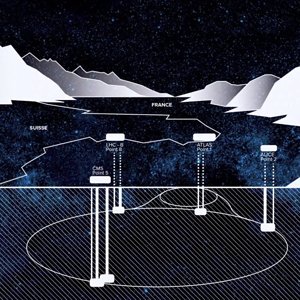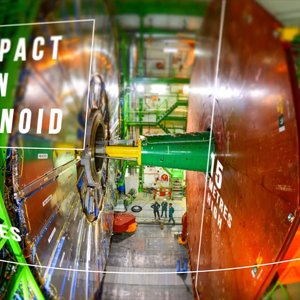You are using an out of date browser. It may not display this or other websites correctly.
You should upgrade or use an alternative browser.
You should upgrade or use an alternative browser.
What is Particle detector: Definition and 13 Discussions
In experimental and applied particle physics, nuclear physics, and nuclear engineering, a particle detector, also known as a radiation detector, is a device used to detect, track, and/or identify ionizing particles, such as those produced by nuclear decay, cosmic radiation, or reactions in a particle accelerator. Detectors can measure the particle energy and other attributes such as momentum, spin, charge, particle type, in addition to merely registering the presence of the particle.
View More On Wikipedia.org
View More On Wikipedia.org
-
C
A The fractional energy loss of charged particle per radiation length
The figure usually has a caption that goes like this: "Fractional energy loss per radiation length as a function of electron or positron energy in lead," but I do not fathom is at (1/E)dE/dx =1, it seems like the particle is losing all of its energy at ~7MeV by ionisation. Therefore, I would not...- CzTee96
- Thread
- Replies: 1
- Forum: High Energy, Nuclear, Particle Physics
-
B
Timing Resolution Required In Particle Detector
Homework Statement A beam on Pions, Kaons and Protons, all with momentum ##\mathrm{P} = 10 \mathrm{GeV}## and negligible angular divergence travels ##100 \mathrm{m}## before hitting a target. What is the required timing resolution of the detector so that pions and kaons can be distinguished...- BOAS
- Thread
- Replies: 1
- Forum: Advanced Physics Homework Help
-

I Possible ways to increase particle detector resolution?
So I'm doing some research for a physics essay on particle accelerators and I don't want to go into too much mathematical detail (as I haven't studied statistics or higher level Physics at school yet), but I have googled a lot of things and nothing seems to come up for methods scientists are...- rageoveralostpenny
- Thread
- Replies: 19
- Forum: High Energy, Nuclear, Particle Physics
-
D
B No traces in cloud chamber (experimental physics)
My setup: plastic box (~1l) with the cover painted black mat the bottom of the box covered with sponges saturated with ethyl alcohol (90%) to the limit (all over sponge capacity poured back to bottle) turned upside down and placed on ~0.5kg of dry ice. I can see a 'rain' of particles of...- diarized
- Thread
- Replies: 5
- Forum: High Energy, Nuclear, Particle Physics
-
J
High Voltage in a Cloud Chamber?
Hello all! Firstly, thanks for reading this post! I am a high school student attempting to make a basic, dry ice cloud chamber. I have made several cloud chamber designs and I am about to start making it. However, before constructing the product I would appreciate some members to provide...- Jayssos
- Thread
- Replies: 17
- Forum: Electromagnetism
-
D
I Why can’t force-carrying particle (spin 0, 1, 2) be detected
Why can’t force-carrying particles (spin 0, 1, 2) be detected by particle detector? Some have masses!- Demian
- Thread
- Replies: 2
- Forum: Quantum Physics
-

CERN Alice Experiment
10 min video for general public, describing the physics aims of the ALICE experiment: the study of the primordial state of matter, the quark gluon plasma and more.- mfb
- Media item
- cern lhc particle detector
- Comments: 0
- Category: Particle
-

LHCb - The Beauty Experiment
A short documentary on the LHCb experiment at CERN, on the quest for the mystery of Antimatter.- mfb
- Media item
- antimatter cern lhc lhcb particle detector
- Comments: 0
- Category: Particle
-

An introduction to the CMS Experiment at CERN
In this video, the CMS detector at CERN's Large Hadron Collider is introduced, describing its construction and history as well as its physics goals.- mfb
- Media item
- cern cms lhc particle detector
- Comments: 1
- Category: Particle
-
J
Particles with electric charges visible to the human eye?
Are there any particles known in the Physics world with an either positive or negative charge that can be viewed by the human eye under LED light illumination and have an attraction/repulsion to magnetism?- Joe Hagner
- Thread
- Replies: 20
- Forum: Electromagnetism
-

Creating a Cloud Chamber for Deflecting Charged Particles
Hello and thanks for reading Homework Statement I'm in high school. I chose my yearly project in physics, and wanted to make a cloud chamber. The subject is "deflection of charged particles in a magnetic field", so I must set a magnet alongside the cloud chamber. I've prepared for it, bought...- Garlic
- Thread
- Replies: 17
- Forum: Introductory Physics Homework Help
-
T
Particle Detector: How Many (e-, ion) Pairs Are Created?
A particle with 900 keV get into the detector and was fully absorbed, how many pair of (e-, ion) are created if one pair required an average of 30 eV.? 900000/30 = 30,000 is this a right answer?- thomsonj
- Thread
- Replies: 1
- Forum: Advanced Physics Homework Help
-
B
Calculating Dark Matter Events in Xenon | 100 GeV, 0.3 GeV/cm3
Assume that the density of dark matter near the Earth is 0.3 GeV / cm3 and that the dark matter particle has a mass of 100 GeV and a velocity of 200 km/s. If the dark matter-nucleon cross section is 10-44cm2 calculate how many events you would expect to see every year in a metre cubed volume of...- Bacilla
- Thread
- Replies: 8
- Forum: Advanced Physics Homework Help